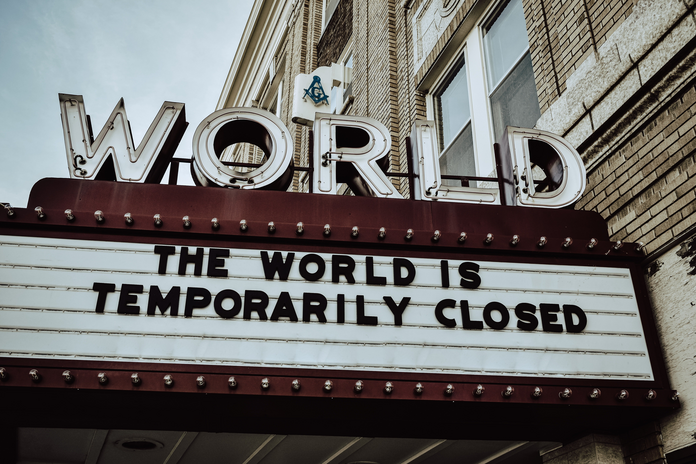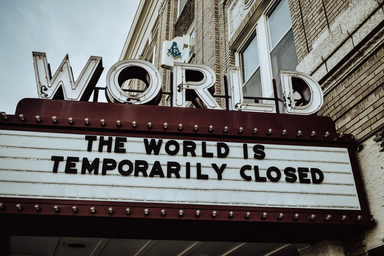When we looked the apocalypse in the eyes, it bowed its head shortly before it started to resemble the world in The Last of Us. There were no bombed-out streets, no fungi worming their way up the sides of buildings. The apocalypse was sterile white coats and industrial hospital lighting, self-conscious jokes about wiping down our groceries, and attending online school. The people most harmed were pushed out of the way, unless they served our political agendas. At first it scared us, then it bored and angered us. The apocalypse came and we moved on.
HBO’s The Last of Us is thought-provokingly claustrophobic, veering wildly into “what could have been” territory. The show, which is adapted from a video game, is set in a dystopian version of 2023, 20 years after an incurable pandemic broke out. The pandemic is caused by a mutated fungus called cordyceps, which causes a person to slowly lose their mind before they die. People now live in quarantine zones (or QZs) managed by the government agency FEDRA, which handles disaster response. A smattering of civilians still live outside the QZs in rural areas, and members of a rebel group, the Fireflies, that work to oppose FEDRA are everywhere. All people live in fear of coming in contact with an infected person.
The series follows Joel, a smuggler haunted by the loss of his daughter right as the pandemic began, who is tasked by the Firefly leader to smuggle a young girl named Ellie out of the QZ in Boston. Ellie has already been bitten by an infected, but it did not affect her — the first time in history one has been able to withstand the infection. The Fireflies want Ellie removed from the QZ and taken to a research facility out west that can study her immunity and attempt to find a cure. Throughout their journey, we watch the two bond before the backdrop of an apocalyptic United States, both learning to love again even though they fear doing so after the losses they have suffered.
Their journey takes them west from Boston to Wyoming, giving audiences a speculative tour of what the United States might look like in a truly apocalyptic scenario. Apocalypse media tends to favor two certain naturescapes: the characters either exist in a burnt out wasteland where plants have overgrown everything and bands of rebels have taken over modern society, or in a gleaming new city of glass and chrome where futuristic technology reigns supreme. Both generally take on an unreal feeling. Apocalypse media is generally designed to show audiences that these dystopian futures are possible because of what’s happening in the present. But in many cases, it’s hard to imagine that the way the scenery looks in a certain movie or show is what our future could look like, because these worlds do not resemble anything we would recognize now. The Last of Us favors the former, but they intentionally create a landscape we know well, one only a few steps away from where we are right now.
As Joel and Ellie drive across the country via interstate, they pass a Love’s gas station–the gas prices have burnt out and the grass on the side of the road is dead and brown, but the brand name is clearly visible. Reflective green highway signs remain intact though the roads are littered with broken cars and skeletons. Joel and Ellie stock up on weapons at a Cumberland Farms. Trails of cordyceps, the fungus that causes the pandemic, run through an abandoned mall, but the tinny video game sound effects, neon arcade lights, and spinning carousel still run. Images of our late-stage capitalist Americana are everywhere: they remind us that in our society’s current tenuous position, it doesn’t take much for it to all come crumbling down, and the remnants of what was will leave their mark on the earth for a long time to come.
What little things do we take for granted in our daily lives? the show prompts us to ask ourselves. As you go through the motions of a normal day, do you ever think about what it would look like if everything you’ve always known suddenly became relics of a bygone time? After episode six, I was left with a heavy sadness. My mind kept returning to the scene where Joel, while walking heavily armed through a college campus to search for members of a rebel group, explains to Ellie what college is. She can’t even imagine a world where people went to class and partied and figured out who they wanted to be in life, a world where survival isn’t at the forefront of everyone’s minds. As a college student, I think about my place in the world all the time. Such thinking is built into the makeup of college, an environment designed to foster self reflection and growth in young people. Who would I be if just a few of my circumstances were altered? Worse, what would our society become?
In March 2020, I spent the first two weeks of the pandemic certain it was temporary, that we really would return to school later that month. I remember in the early months craving feel-good stories about neighbors dropping off dinners for neighbors, or people coming out onto their balconies to sing songs as a group from six feet apart. After that, everyone I knew became supremely certain the apocalypse was upon us. I remember crippling loneliness – the pandemic didn’t bring my politically divided hometown together like it did the places I saw on social media — it tore it apart. A piece of cloth with a filter in it became a political rallying cry. Millions of people, now dead from COVID, became nothing more than political pawns. I remember the anger my neighbors felt for each other, anger so toxic it sucked the life from our community.
Emotionally, I felt we were just as fractured as the society in The Last of Us. The same resentment of the government, the same fear, both of the pandemic and of our neighbors. But in actuality, our lives have returned to almost exactly the way they were pre-pandemic. We can go out to eat at restaurants and attend concerts. Masks are no longer required or even suggested at most places: to wear one comes across as an intentional political choice rather than a healthcare one. None of our government institutions collapsed, and little meaningful policy change was made. We don’t live in QZs, and no rebel outlaw groups have taken over. We don’t even fear infection anymore. For some, it’s merely an inconvenience.
The Last of Us pushes us to question this remarkable privilege: normal life. How did we get as close to the brink as we did, only to return to almost normal? How did we get so lucky? We should be thanking the heavens every single day for our good fortune. What would it have looked like if the COVID-19 pandemic played out even a tiny bit differently? Could we be in the same situation as Joel and Ellie? Emotionally, aren’t some of us, like the ones that lost people to COVID, already there?
The show appears intentionally structured to resemble our lives as much as possible, some moments shocking us with their similarity and normalcy, despite the pandemic-ravaged world. The first episode opens in 1968 with an author and an epidemiologist being interviewed on TV about how they think a pandemic situation might play out. One says our biggest concern should be a virus that travels through the air, another says it will come from fungus. As they discuss how the end of the world will come, they make light-hearted jokes and smoke cigarettes. Given that we know how dark things will get within the world of the show, their good-naturedness is shocking. But isn’t it real? Wasn’t there a time when we didn’t fear COVID, and haven’t we returned to that position now? In episode seven, Ellie, who has never known life outside of the pandemic, visits a mall with her crush, Riley. Everything that is normal to us, from the photo booth she thinks is a time machine to the arcade that offers cheesy early-2000s games, is magical to her. If everything you’d ever known was stripped away–for real this time, not just for a short period where the worst thing that happened to some of us was we couldn’t see our friends–what would you miss most? What would you never again take for granted?
Despite all of this darkness and rumination, the backbone of the show is the undying human need to love. After everything the characters know is stripped away, after doing things to survive they could never have imagined in the before times, what Joel and Ellie are both most afraid of is opening their hearts to love again.
The show’s resemblance to our current lives and the way it demands reflection makes it claustrophobic yet gripping. It shows the way late stage American capitalism would live on, its symbols of control that we barely notice–brand names, billboards–constantly looming out of an apocalyptic wasteland. It shows the way political differences could lead to irreparable violence. And it shows that no matter how dark it gets, no matter how broken our society gets, nothing is stronger than the love we are capable of feeling for one another.
If you would like to write for Her Campus Mount Holyoke, or if you have any questions or comments for us, please email hc.mtholyoke@hercampus.com.

